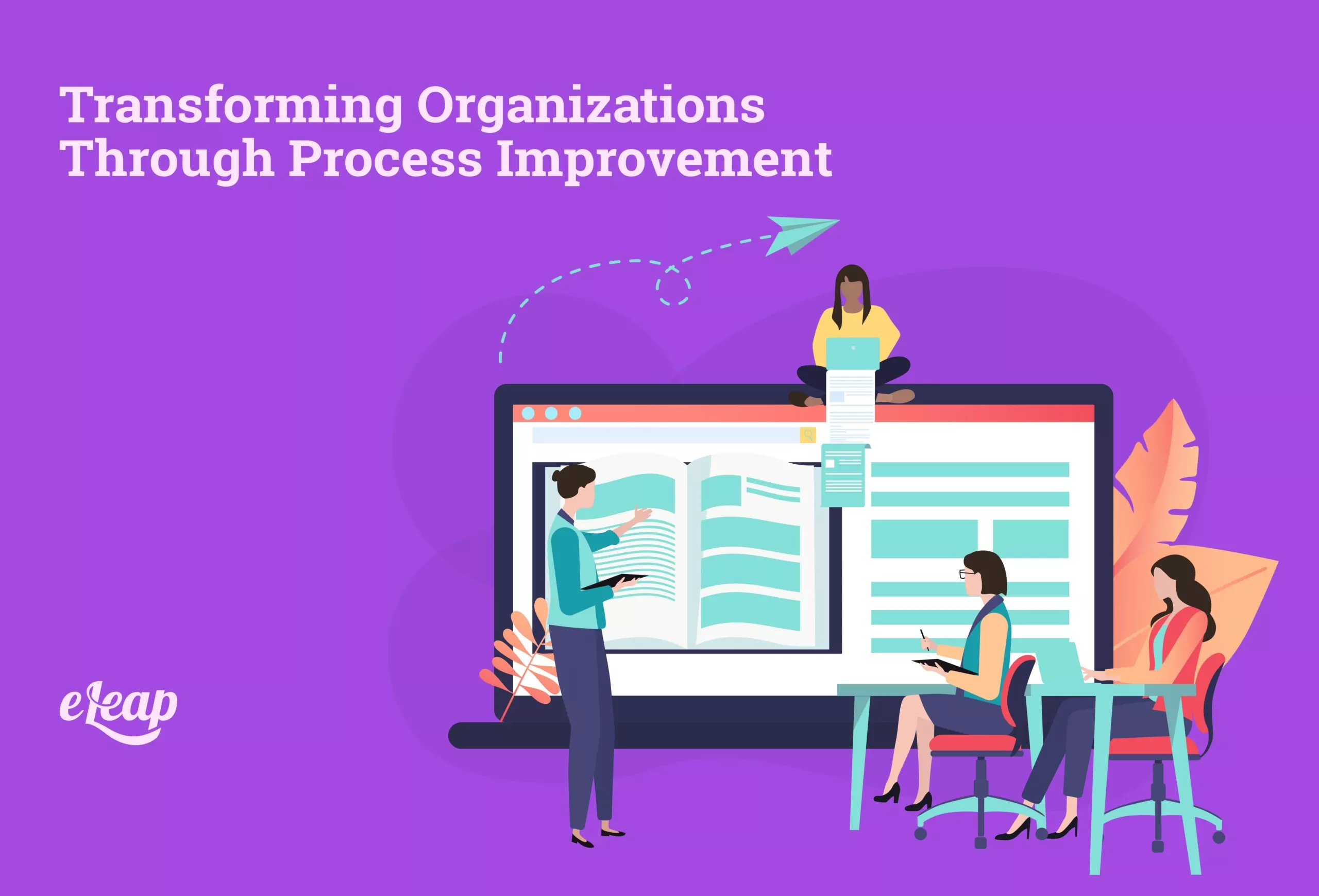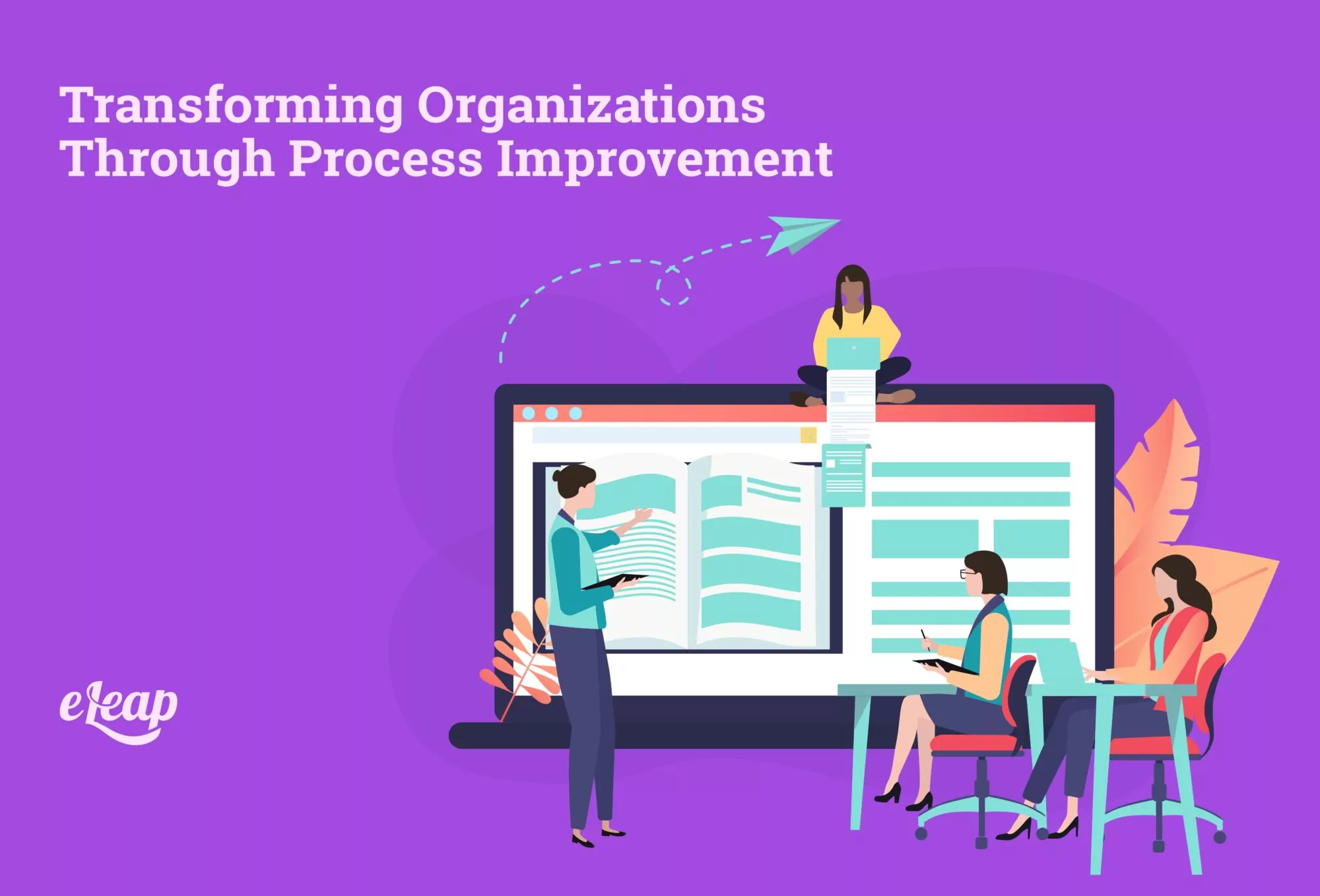Transforming Organizations Through Process Improvement

Process improvement is critical for any organization looking to streamline operations, boost productivity, and deliver better customer value. Process improvement focuses on optimizing existing workflows, eliminating inefficiencies, and ensuring that business processes are aligned with organizational goals. This approach has the potential to transform businesses by helping them adapt to changing market conditions, remain competitive, and drive long-term success. Explore how eLeaP®’s Performance Management Platform can simplify evaluations, boost productivity, and drive measurable results.
In this article, we will explore the significance of process improvement, its methodologies, how to implement it effectively, and the key tools that can help organizations on their journey toward operational excellence.
What is Process Improvement, and Why It Matters?
Definition of Process Improvement
Process improvement refers to the ongoing effort to enhance business operations by identifying inefficiencies and finding ways to improve them. This stage is achieved by evaluating current processes and implementing changes that result in a more efficient and effective workflow. The goal is always to increase customer value while reducing waste and optimizing resources.
Core Benefits of Process Improvement
The benefits of process improvement are far-reaching. When executed effectively, organizations can experience significant improvements across various areas. Some of the key benefits include:
Enhanced Efficiency: Process improvement can reduce time spent on tasks and eliminate unnecessary delays by identifying bottlenecks, eliminating redundant steps, and optimizing workflows. This process leads to greater productivity across the organization.
Reduced Costs: Streamlining processes often results in cost savings, as organizations eliminate waste, use fewer resources, and optimize their operations.
Improved Quality: By focusing on standardizing processes and removing variability, organizations can improve the quality of their products and services, increasing customer satisfaction.
Employee Engagement: Engaging employees in process improvement initiatives can boost morale. They feel valued for their input and are more likely to be engaged in their work, which can lead to improved performance.
Customer Satisfaction: Ultimately, process improvement aims to enhance customer satisfaction by delivering products and services that meet or exceed customer expectations in a more timely and cost-effective manner.
The Role of Process Improvement in Organizational Transformation
Streamlining Operations for Greater Efficiency
One primary reason organizations pursue process improvement is to streamline their operations. Many businesses have outdated practices, inefficient workflows, and unnecessary complexities that slow progress. Process improvement identifies and eliminates these inefficiencies, making daily operations smoother and more efficient.
For example, manufacturing companies can improve production lines by reducing downtime between machine operations or implementing better inventory management practices to reduce waste. Service-based industries can optimize call-handling times and improve service response by refining internal procedures.
Aligning with Business Objectives and Customer Needs

Process improvement involves fixing inefficiencies and aligning operational processes with broader business objectives. A successful initiative ensures that every change made in the workflow directly supports the organization’s strategic goals.
Focusing on customer needs and expectations can also ensure that organizations’ processes are designed to deliver maximum value. This process might involve shortening lead times, improving response rates, or offering more tailored services to customers.
Building a Culture of Continuous Improvement
Process improvement isn’t a one-time project; it’s an ongoing journey. To truly transform an organization, process improvement needs to become part of the company’s culture. This stage requires leadership’s commitment to fostering a culture of continuous improvement, where employees at all levels are encouraged to identify opportunities for optimization.
Engaging employees in this process is essential. When people feel empowered to contribute ideas for improving processes, they create a sense of ownership and collaboration that benefits the entire organization. Leaders should actively seek employee feedback, set measurable improvement goals, and continuously review processes to ensure the organization continues progressing.
Methodologies for Process Improvement: Choosing the Right Approach
Various methodologies exist to guide organizations through the process improvement journey. Each has strengths that can be applied to meet an organization’s needs. Let’s explore some of the most widely used approaches.
Business Process Improvement (BPI)
Business Process Improvement (BPI) systematically examines and enhances existing processes. It is a targeted approach that examines individual processes to identify areas for improvement. By combining process mapping, data analysis, and employee feedback, BPI helps organizations pinpoint inefficiencies and develop strategies to address them.
Business Process Management (BPM)
While BPI focuses on improving specific processes, Business Process Management (BPM) takes a broader approach. BPM integrates process improvement with organizational management to ensure that processes align with the overall strategy. It improves existing processes, automates them, and monitors them to ensure their effectiveness over time.
BPM tools, such as workflow automation platforms, help organizations optimize and automate repetitive tasks, ensuring processes run smoothly even when changes occur.
Lean Methodology
The lean methodology aims to reduce waste while increasing valuations to minimize inefficiencies. The main principles of the lean approach, which eliminates non-value-added activities, include identifying value from the customer’s perspective, mapping the value stream, creating flow, establishing pull systems, and pursuing perfection.
The lean methodology can be particularly beneficial for manufacturing, healthcare, and other industries that require precise and efficient processes.
Six Sigma
Six Sigma is a data-driven methodology that seeks to improve the quality of processes by identifying and eliminating causes of defects and variability. Using statistical tools, Six Sigma focuses on reducing the number of defects in a process to fewer than 3.4 per million opportunities. This methodology emphasizes a rigorous, data-centric approach to process improvement and is commonly used in industries like manufacturing, engineering, and healthcare.
Agile Process Improvement
The Agile methodology, initially developed for software development, has also been applied to process improvement. Agile focuses on flexibility, collaboration, and iterative development. Instead of implementing sweeping changes all at once, Agile encourages organizations to make minor, incremental improvements through short cycles, known as sprints. It is especially effective in fast-paced or constantly evolving environments like tech startups and software companies.
Continuous Process Improvement (CPI) and Kaizen
Continuous Process Improvement (CPI) is an ongoing effort to make small, incremental process changes over time. Kaizen, a Japanese term meaning “change for the better,” is a fundamental principle of CPI. The goal is to foster a culture of continuous improvement where every employee, from top to bottom, is committed to making minor improvements regularly. This approach can be efficient for organizations that want to achieve steady progress without requiring large-scale changes.
How to Implement Effective Process Improvement
Mapping and Analyzing Current Processes
The first step in process improvement is to understand the current state of affairs. Organizations need to map out existing processes and analyze their performance. This process involves creating visual representations of workflows, identifying bottlenecks, and gathering data to assess performance.
Modern tools, like business process management software and process mapping tools, can help organizations accurately capture the current state of their operations. Data collected during this phase provides the foundation for improvement initiatives.
Identifying Bottlenecks and Improvement Areas
Once processes are mapped, the next step is identifying areas for improvement. This stage involves recognizing bottlenecks or areas where delays or inefficiencies occur. It’s essential to focus on the most critical processes impacting the business.
For example, a company might identify a slow approval process in its accounting department that delays vendor payments. Addressing this issue can speed up transactions and improve vendor relationships.
Setting Clear, Measurable Goals for Process Improvements
Successful process improvement requires clear, measurable goals. Organizations should define specific objectives, such as reducing production time by 20% or improving customer satisfaction scores by 10%. By setting SMART (specific, measurable, achievable, relevant, time-bound) goals, organizations can track progress and stay focused on their targets.
Implementing and Monitoring Changes
Once goals are set, organizations can implement the necessary changes. This stage may involve process re-engineering, automation, or adopting new tools. After changes are made, it is crucial to monitor the results closely to ensure that improvements are realized.
Effective monitoring systems, such as Key Performance Indicators (KPIs), help track success. If results don’t meet expectations, it’s essential to analyze what went wrong and adjust the approach accordingly.
The Role of Technology and Automation in Process Improvement
The Growing Role of Automation in Business Processes
Automation is becoming increasingly important as businesses look for ways to improve their processes. Technology can help organizations automate repetitive tasks, reduce human error, and free up employees to focus on higher-value activities.
For instance, automated data entry systems can significantly reduce the time spent on manual tasks. Robotic Process Automation (RPA) can automate workflows in finance, healthcare, and customer service industries.
Tools and Software for Process Improvement
Various software tools are available to help organizations improve their processes. Business process management (BPM) software, workflow automation tools, and project management platforms can all contribute to more efficient operations. Platforms like eLeaP also help organizations streamline training and development, ensuring employees are well-equipped to contribute to process improvement efforts.
Real-World Examples of Successful Automation
Many companies have successfully used automation to improve their processes. For example, in the banking industry, automation of loan application processing has reduced approval times from weeks to days, improving customer satisfaction and operational efficiency.
Overcoming the Challenges in Process Improvement
Resistance to Change: Strategies to Overcome It
One of the biggest obstacles to process improvement is resistance to change. Employees and managers may be reluctant to adopt new working methods due to fear of the unknown, comfort with existing processes, or concerns about job security. Overcoming this resistance requires clear communication, proper training, and involving employees.
Lack of Cross-Departmental Collaboration
For process improvements to be successful, cross-departmental collaboration is essential. Silos can hinder progress, so it’s vital to ensure that all departments work together to identify and implement improvements.
Aligning Improvements with Business Strategy and KPIs
Process improvement efforts must align with the organization’s strategic objectives to be truly effective. They may not have the desired impact if they don’t directly contribute to key business goals. Aligning improvements with KPIs ensures that every effort is measurable and tied to the company’s overall performance.
Inadequate Resources and Training
Organizations may also face challenges related to resource allocation and employee training. Process improvement initiatives require time, money, and expertise. Ensuring that employees have the necessary skills and that leadership provides adequate resources can make all the difference in the success of an improvement initiative.
Case Studies: Real-World Examples of Successful Process Improvement
Case Study 1: Manufacturing Industry
In manufacturing, a company adopted Lean and Six Sigma methodologies to reduce waste in its production line. By streamlining its processes and eliminating bottlenecks, the company reduced production time by 15% and cut operational costs by 20%.
Case Study 2: Service Industry
A service-oriented business implemented Business Process Management (BPM) to streamline its customer support operations. By automating customer inquiries and improving internal communication, the company improved customer satisfaction by 25% and reduced response times by 30%.
Case Study 3: Technology Industry
A software company refined its product development cycle using Agile process improvement techniques. By adopting short sprints and continuous feedback loops, the company reduced its time to market by 40% and increased product quality.
Measuring the Success of Process Improvement Initiatives
Key Performance Indicators (KPIs) to Track
Organizations should use KPIs to measure the success of their process improvement efforts. Common KPIs include customer satisfaction scores, cycle times, production costs, and employee engagement levels.
Continuous Feedback and Iteration
Process improvement is ongoing; feedback is essential to ensuring sustained success. Organizations can maintain momentum and achieve long-term transformation by continuously collecting data, monitoring performance, and making iterative improvements.
Conclusion
A continuous enhancement culture is the key to long-term organizational transformation through process improvement. By systematically evaluating and optimizing processes, aligning improvements with strategic goals, and embracing technology, businesses can improve efficiency and deliver more excellent value to customers.
With the right approach, process improvement becomes a powerful tool for achieving operational excellence and staying ahead in an increasingly competitive landscape.